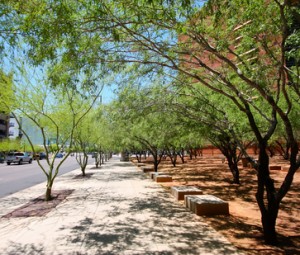View Source | September 23, 2014
 ASU researchers from the Center for Integrated Solutions to Climate Challenges and Decision Center for a Desert City, in partnership with the City of Phoenix, released a report this summer evaluating the city’s Cool Urban Spaces work. The report, Urban forestry and cool roofs: Assessment of heat mitigation strategies in Phoenix, evaluated two initiatives to reduce temperatures in Phoenix: the Phoenix Cool Roofs project and the Tree and Shade Master Plan.
ASU researchers from the Center for Integrated Solutions to Climate Challenges and Decision Center for a Desert City, in partnership with the City of Phoenix, released a report this summer evaluating the city’s Cool Urban Spaces work. The report, Urban forestry and cool roofs: Assessment of heat mitigation strategies in Phoenix, evaluated two initiatives to reduce temperatures in Phoenix: the Phoenix Cool Roofs project and the Tree and Shade Master Plan.
The urban heat island, or increased temperatures in cities relative to surrounding areas, is a significant problem in Phoenix and a priority for scientists and city officials alike. According to the study, increasing tree canopy is an effective way to cool city infrastructure, thereby mitigating the urban heat island effect. In fact, the study found that increasing tree canopy cover from the current level of about 10 percent to 25 percent could reduce the temperature of a typical Phoenix neighborhood by 4.3 degrees Fahrenheit.
Though cool roofs alone had limited impact, researchers found that they added to the cooling effect when combined with trees. City officials will use these findings to guide future urban heat mitigation efforts.

